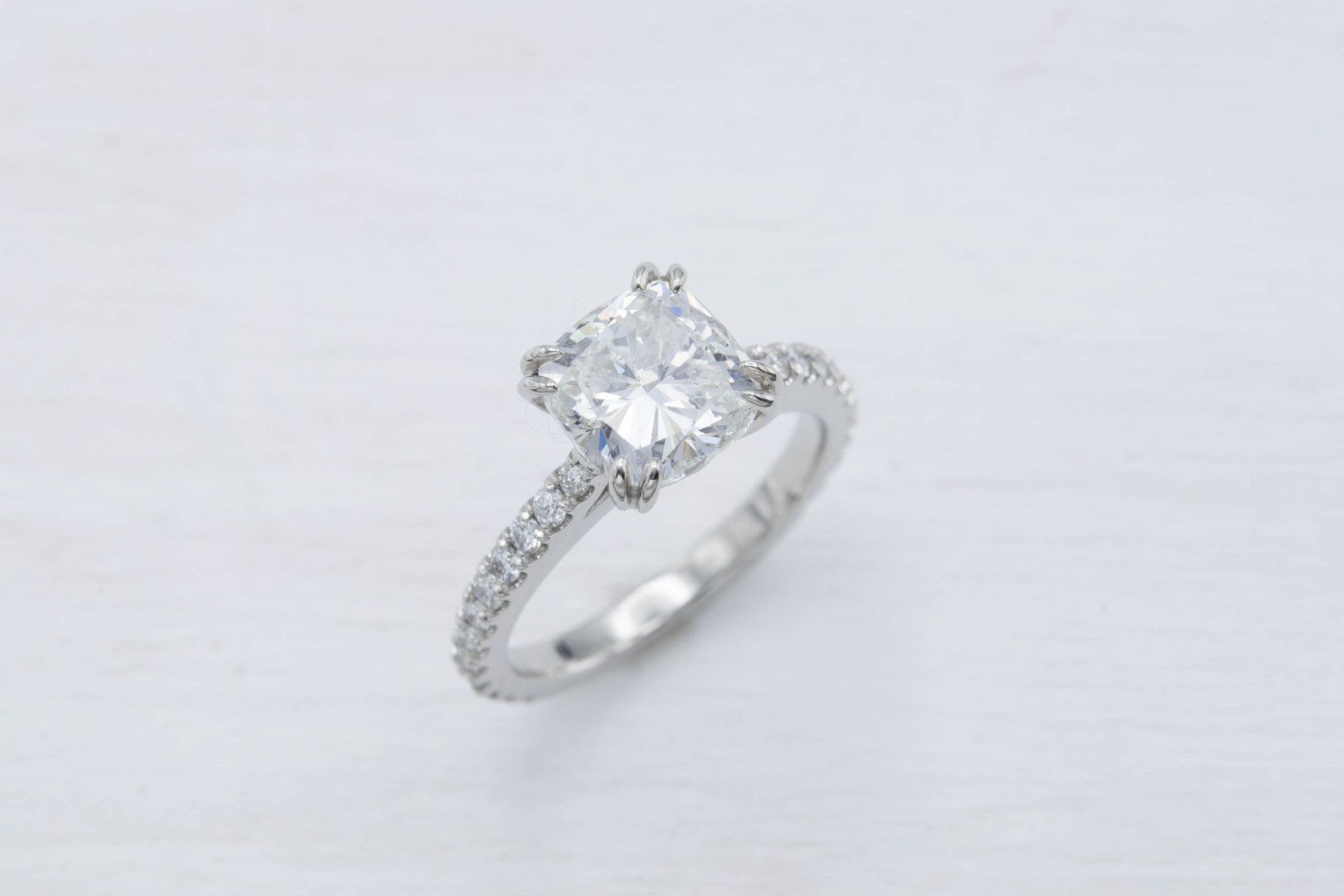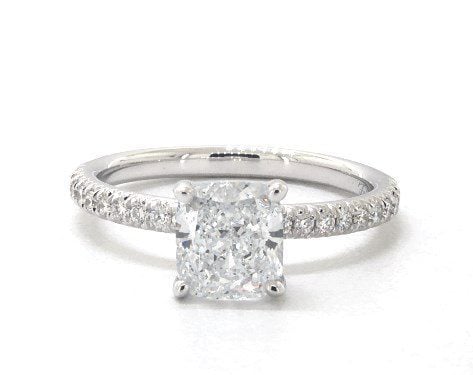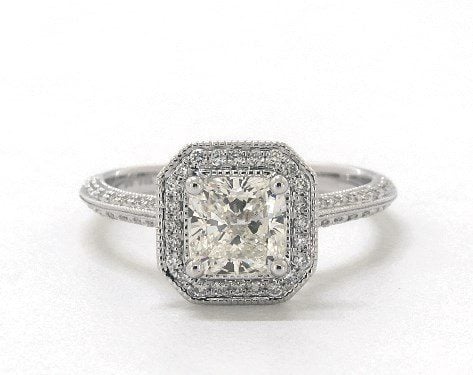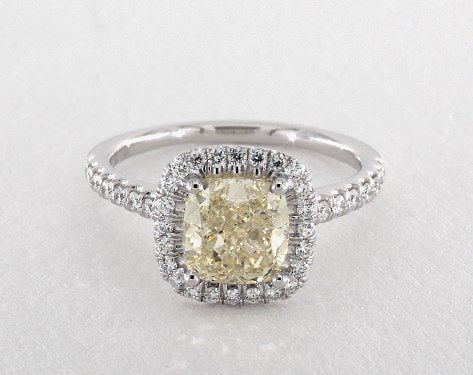Cushion Cut Diamonds: A Complete Buying Guide
With elegant curves, cushion-cut diamonds have a classic, timeless style. Learn the pros and cons of cushions and how to find the best one for your ring.
10 Minute Read
Read about the pros and cons of cushion-cut diamonds and how they stack up against round and princess cuts. Then, learn how to judge the quality of a cushion-cut diamond and choose the perfect natural or lab-created one for your engagement ring.
at CustomMade
What is a Cushion Cut Diamond?
Cushion cut diamonds have a square or rectangular shape with rounded edges, resembling a pillow and giving them their name. Although they are not as brilliant as round cut diamonds, they have a greater fire, meaning they will display more bright colors from within the gem when viewed at different angles. Cushion cut diamonds are considered modern versions of the Old Mine Cut, the most popular round diamond cut through the early 1900s, giving them a more vintage look than a round diamond.
Pros and Cons of a Cushion Cut Diamond Engagement Ring
Cushion cut diamonds have a timeless and classic appeal, with soft, rounded edges that no other shape can rival. They're also the cut with the most dispersion, or fire. If you love those colored flashes of light coming from a diamond, you'll cherish a cushion-cut diamond engagement ring.
Still, cushions have a downside. Being one of the deeper cuts, they have a smaller face-up size than most shapes. That means you might want to look for a stone with a slightly larger carat weight.
Cushion Cut Diamond vs Round Cut Diamond
While round diamonds have the most brilliance, or return of white light, cushion-cut diamonds can have more fire than rounds (though rounds still have plenty of fire).
However, the major advantage of choosing a cushion-cut diamond is its price. Like other fancy shapes, choosing a cushion over a round can save you over 25%! For example, the James Allen rose gold solitaires shown below differ in price by nearly $1,000 ($5,120 for round, $4,140 for cushion). The difference doesn't come from the specs. They're both 1-ct, I color, VS2 stones, so the difference in price comes primarily from their shape.
Cushion Cut Diamond vs Princess Cut Diamond
The most important factor in choosing a diamond shape is style. Either you love it or you don't. Cushions are great for soft halos and vintage settings, while the sharp edges of princess-cut diamonds give them a modern appearance. Princess cut diamonds make for beautiful, geometric three-stone rings and edgy solitaires.
Because of the popularity of the princess cut, you can save a little money by choosing a cushion. However, the cushion will appear slightly smaller than the princess cut diamond. This is because your eye automatically looks at the longest length, from corner to corner. Since cushion-cut diamonds have rounded corners, they appear smaller.
Evaluating Cushion Cut Diamonds
Let's take a closer look at cut, color and clarity of cushion cut diamonds so you can judge the quality of this diamond and not waste your time or money.
Cushion Cut Diamond Cut
With a silhouette that resembles a pillow, the cushion's unique shape is one of the most complicated for first-time diamond buyers. Keep in mind that judging cut quality in a cushion-cut diamond isn't an exact science. What's most important is that you like the stone's look and performance.
Standard and Modified Brilliant Cushion Cuts
Unlike most other fancy shapes, cushions can be created from several different cut patterns. Although you'll find the standard cut in older diamonds, it's still used today. In the 1920s, a new modified cushion entered the market, with an extra row of facets below the girdle. So, when you're searching, you may see the description "cushion modified." This is still a cushion cut diamond.
However, whether the diamond has a standard or modified cushion cut doesn't have a direct impact on its beauty or performance. Either type can have great or poor performance. Furthermore, both cuts can display each of the two "looks" of a cushion-cut diamond.
"Chunky" and "Crushed Ice"
While looking for your perfect cushion, you'll notice that there are two different "looks" for a cushion-cut diamond. Some will let you see the back facets and light reflections in broad flashes. These are lovingly called "chunky" cushions.
Some cushion cut diamonds have an appearance similar to crushed ice or broken glass. Here, the back facets aren't distinct. Instead, you'll see a glittering effect of many tiny reflections.
This is the biggest aesthetic concern for a cushion-cut diamond. Take some time to peruse the pictures and examine the performance of these examples to help you decide which of these looks you like better.
Length-to-Width Ratio
Another major aesthetic decision in a cushion cut diamond is whether you prefer a square or rectangle shape. While most available diamonds are square, rectangles have the advantage of appearing larger for their carat weight.
You'll want to look at the length-to-width ratio (L/W) for cushion cuts. Square shapes should have an L/W of 1.00 to 1.05. Rectangular shapes should be significantly — but not overly — elongated, with L/W of 1.15 to 1.20. Avoid the L/W "awkward zone" of 1.06 to 1.10. The shape of these diamonds looks too square to be rectangular and too rectangular to be square. Take a look at these cushions from James Allen with a wide range of L/W.
Elongated cushion-cut diamonds are less common than square shapes and, thus, harder to find in high quality. Be prepared to do some searching if you're shopping for an elongated cushion.
Shape Appeal
Cushion cut diamonds can range from nearly round to nearly square. You'll want one that's an attractive middle ground, with rounded corners and slightly curved sides. It's essential to have a good image of the diamond to see its shape clearly. If the shape appears off, don't buy it. A laboratory report won't tell you anything about shape.
Here are three particularly extreme cushion shapes from James Allen.
Depth and Table
For the best performance, limit your search to diamonds with both depth percentage and table percentage under 70%. This won't eliminate all poorly performing diamonds, but it will make your search easier. Make sure you review the video of each diamond you consider to ensure it performs well.
Hearts and Arrows
If you're looking for the best possible cut, you may be drawn to cushion-cut diamonds with Hearts and Arrows. While these cushions have great performance, cushion-cut diamonds without the hearts-and-arrows pattern can also perform brilliantly. Furthermore, only "chunky" cushions will show this design. If you prefer "crushed ice," don't get a Hearts and Arrows cushion.
Cushion Cut Diamond Color
While cut quality is the most important factor in a diamond's beauty, you'll also want to consider the diamond's color grade. Cushion shapes show more color than a round brilliant, but their brilliance and dispersion help to hide color.
For a cushion-cut diamond set in a white gold engagement ring, stick to a color grade of H or higher. If you have a tight budget, you can drop to an I or even some J color diamonds and still have a white look.
at James Allen
In rose gold and yellow gold rings, I and J color diamonds will give you a better price point and will still appear white. K-color cushions will have a slight tint, which can work well for vintage styles.
at James Allen
Cushion Cut Diamond Clarity
Eye-visible clarity imperfections can ruin the appearance of a cushion-cut diamond. However, the brilliance of a cushion will hide imperfections well. For the best price point, stick to VS2 and SI1 clarity grades. If you need to stretch your budget, plenty of cushion cut diamonds with an SI2 clarity grade will appear clean to the eye. Even some I1 diamonds (like this beauty) will be eye-clean.
For SI1 and SI2 diamonds, look closely at the diamond and be sure that the imperfections aren't large, dark, and in the center of the stone. These are the most noticeable. If you're not sure whether your cushion will be eye-clean, review the diamond with an expert. They can help you determine whether clarity imperfections will be visible or impact the diamond's durability.
Cushion Cut Lab Grown Diamonds
Should I Buy a Cushion-Cut Lab-Grown Diamond?
If you are contemplating purchasing a cushion-cut lab-grown diamond, there are several factors to consider before making your decision.
Lab-grown diamonds offer numerous advantages, such as being more environmentally friendly and ethically sourced compared to mined diamonds. They possess the same physical and chemical properties as natural diamonds, ensuring a stunning and durable gem.
Additionally, lab-grown diamonds tend to be more affordable, allowing you to get a larger or higher-quality stone for your budget. Here are two identical stones from James Allen to illustrate this point.
at James Allen
at James Allen
With their excellent craftsmanship and increasing popularity, a cushion-cut lab-grown diamond presents an excellent choice for both conscious consumers and those looking for exceptional value without compromising on brilliance and elegance.
How to Buy a Cushion-Cut Lab-Grown Diamond
When looking to purchase a cushion-cut lab-grown diamond, several essential steps can guide you through the process.
Firstly, educate yourself about lab-grown diamonds, understanding their characteristics and grading standards. Next, set a budget and determine the diamond's specifications, such as carat weight, color, clarity, and cut quality. Then compare prices and options to find the best value for your budget. Finally, examine the diamond's appearance and brilliance in person or through high-quality images and videos before making your final decision. With careful research and attention to detail, you can confidently purchase a stunning cushion-cut lab-grown diamond.
at Blue Nile
at Blue Nile
Cushion Cut Fancy Colored Diamonds
Fancy colored diamonds are a trend that is here to stay. Elevate your jewelry collection with the allure and glamour of a cushion cut fancy colored diamond. Pairing their distinct hues with the captivating cushion cut, you'll unveil an incomparable piece destined to be adored.
Discover these coveted gems at James Allen and Blue Nile, boasting a wide range of colors, sizes, and cuts on their sites. Whether your taste leans toward serene greens, vibrant pinks, or ethereal blues, natural fancy colored diamonds promise to elevate the elegance of any jewelry piece, from engagement rings to delicate stud earrings.
at James Allen
at James Allen
at James Allen
Cushion-Cut Summary
- 1. This is the cut with the most dispersion, or fire
- 2. Cushions are great for soft halos and vintage settings.
- 3. Choosing a cushion cut over a round can save you over 25%!
Where to Buy a Cushion-Cut Diamond Engagement Ring
With cushion-cut diamonds, it's essential to review images and videos to make sure your diamond is up to your standards. There's no way to tell from a grade report whether the diamond has a "chunky" or "crushed ice" look. The report also can't tell you if the shape is off.
Both Blue Nile and James Allen make it possible for you to view your diamond online in 360°, giving you an informed idea of the diamond's appearance and performance.
While both have extensive diamond databases, James Allen has many more options for ring settings. Furthermore, James Allen allows you to see ring and diamond combinations that other customers have purchased. This will help you get a better idea of the finished engagement ring.
However, Blue Nile has one advantage over James Allen for cushion cut diamonds. Blue Nile's search allows you to limit the L/W ratio. If you're looking for an elongated cushion cut diamond, Blue Nile might be a better option.
If you just can't seem to find what you're looking for, check out CustomMade. Their experts can help you find the perfect cushion center stone and place it in a ring that's truly unique. With their guidance, you can create your dream ring.
at James Allen
FAQs
1. Is cushion cut a good diamond?
Cushion cut diamonds are a great choice if you are looking for a diamond with a classic look and bright, fiery sparkle. Well-cut cushion cut diamonds have the highest dispersion of any cut, which refers to the colored flashes that come from within a diamond. Cushion cut diamonds also have high brilliance, making them especially bright and radiant.
2. Is cushion cut diamond cheaper than round?
Cushion cut diamonds can be up to 25% cheaper than round cut diamonds, making cushion cuts a great choice if you are looking for a brilliant diamond on a tighter budget. Although cushion cut diamonds have a slightly smaller face-up size than round cut diamonds, the significant difference in price will make up for the slight difference in size.
3. Are cushion diamonds more expensive?
Cushion cut diamonds are far less expensive than round cut diamonds of the same carat weight. This is because they are far less popular of a shape, but their similar look to round cut diamonds makes them a great choice if you are on a budget and don't want to sacrifice style or size.
Addison Rice
A geologist, environmental engineer and Caltech graduate, Addison’s interest in the mesmerizing and beautiful results of earth’s geological processes began in her elementary school’s environmental club. When she isn’t writing about gems and minerals, Addison spends winters studying ancient climates in Iceland and summers hiking the Colorado Rockies.
Related Articles
Diamond Value, Price, and Jewelry Information
Engagement Ring Setting: What’s Your Style?
Before Buying a Diamond: 9 Tips You Should Know
A Visitor’s Guide to Colorado Gemstones
Latest Articles
Amethyst Sources Around the World: The Geological Story Behind These Purple Gemstones
Brazilianite Value, Price, and Jewelry Information
Ruby-Glass Composites vs Leaded Glass Clarity Enhancements
Morganite Buying Guide
Never Stop Learning
When you join the IGS community, you get trusted diamond & gemstone information when you need it.
Get Gemology Insights
Get started with the International Gem Society’s free guide to gemstone identification. Join our weekly newsletter & get a free copy of the Gem ID Checklist!



